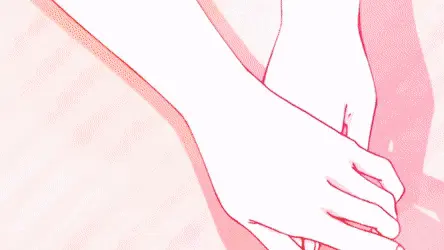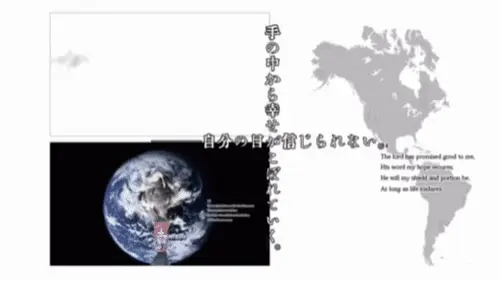M@D Movies
Last updated 2025- 7-25, 3:25:45 P.M. UTC+00:00
More than just AMVs
When we've been there ten thousand years
Bright shining as the sun
We've no less days to sing God's praise
Than when we first begunAmazing Grace, as presented in Tooi Sora no Mukou ni
Manifest Destiny
The anglophone Internet is well familiar with Anime Music Videos/AMVs where anime clips are edited to various types of music. In my humble opinion, the laborious process of clip-finding and cutting them to the beat alone has very limited and fast-diminishing returns, simply because of the much more limited creative freedom this process locks you into. Further creative pathways building on top of this medium often involve extensive masking of anime clips, which tend to be even more laborious are thus less explored. So what could be achieved, if we look beyond "anime clips"? What can amateur visual derivative content creators truly achieve with the potential of modern technology for digital video editing?
More on history
If you're interested, here are a couple of places where you can find more about the fascinating past of MAD movies:
History
It is said that the most convincing origin for modern MAD videos is the late 1970's' "Mad Tapes" from Japanese college circles, with "mad" here having its literal meaning of "craziness". These were audio cassette tapes that were distributed in the same places as doujinshis of the time. These soon got relatively popular and small communities started to pop up in manga and anime circles around the country. Independent showings were held in underground circles.
Towards the 21st century, home computer technology has evolved to the point where the right mindset and the right tools provided a powerful venue to video and audio editing. Riding on the rise of P2P distribution channels, the modern MAD movie has effectively taken shape.
NiVE
Many were fast to point out After Effects's high bar to access. There was an effort to effectively clone the functionalities of After Effects in the now fairytale-like NicoVisualEffects (NiVE). I actually could not tell that it was not After Effects for a hot second when I first saw the UI. NiVE also saw documented adoption in some otoMAD circles, it has now become a part deep in the otoMAD iceberg while AviUtl continued to be popular.
The late Flash technology also played a significant role as web animations were popular during the Golden Era of Flash. Though there were many adopters of After Effects even back in 2004.
Seishiga (静止画)
As before, with anime edits, not unlike AMVs, it is harder to expand creative visions with them due to their inherent dynamicity and polish. It is much more common to see seishiga (lit. still-image) MADs, where the source material chosen is usually manga or visual novel assets.
Copyright
Shingei Koubou
Shingei Koubou (神藝工房), or officially in English, Shingei Factory
Among them, Katakiri Rekka went on to become a popular vocalist under this alias. Her works include the ending theme for the original season of the Higurashi anime.
Tsukune is an excellent creator in his own right who worked on the legendary openings for some of the minori games with Shinkai Makoto (新海誠), and became a renowned After Effects expert.
In January of 2001, Shingei Koubou was hit by a cease-and-desist ultimatum from VisualArts/Key. This event sent shockwaves through the MAD circles at the time and directly led to the dissolution of Shingei Koubou in November.
Around that time, Kanzuki Yashiro operated his own brand Radiant Impression Prelude commercially. Around 2006, he started the studio Mju:z, and eventually made the opening movie for Key's Little Busters, funnily enough.
The inherent nature of such derivative content begs for a question on copyright, if you don't ever contact the author to your source material (video or audio). You may be tempted to say their transformative nature implies fair use, but allow me to remind you that that's only a thing in US law. While this doesn't happen often nowadays, in the early days many MAD creators suffered substantially due to copyright holders' reluctance to embrace fan content.
Terminology
Nowadays, "MAD Movie" usually refers to anime or more commonly seishiga edits, the ones with much effort put in storytelling and visual communication. "otoMAD" (音MAD), (literally, Sound MAD) is used to specifically to refer to videos for which the audio is also a part of the creative process. Originally cassette tapes could only capture audio, so essentially, when video technology came along, it had hijacked the term. (And due to certain English speakers' unfamiliarity with kanji, the oto kanji is often omitted when people who are only familiar with otoMADs try to refer to one of these, creating even more confusion.)
Events
The MAD circles have hosted many events throughout the 2000's and into the 2010's. I would like to mention some notable ones, more can be found documented here. Here is an up-to-date portal for up-to-date information on the modern MAD scene, including many announcements of the latest events.
Kouhaku Mubi Kassen (紅白夢寐合戦)
The Kouhaku Mubi Kassen (lit. Red-White Dreaming Battle) is a competetion held annually from 2005-2008, my personal favorites have come from this event. The participants are divided into two teams like all Red-White events in Japan.
MADMAX
MADMAX is the annual event held by Gunma (軍魔). It is a closed stage for some of the most celebrated creators in the community. It usually lasts 5-8 days, with each day of the event having two creators battling it out. A vote is held for every day of the event to determine a winner.
A-Ni-Pa-Ru AMV/MAD FESTIVAL in JAPAN (あ・に・ぱ・る AMV/MAD FESTIVAL in JAPAN)
This is the annual event championed as the "biggest" nowadays, also known as AniPAFE. Many more recent gems have come from here.
MMGC (黄金祭)
MMGC (Mirai MAD Gold Contest) is a more recent event hosted by the Chinese MAD group Mirai MAD Team. It has seen a lot of activity.
Anata ga Erabu Seishiga M@D Taishou (あなたが選ぶ静止画M@D大賞)
Anata ga Erabu Seishiga M@D Taishou is the annual vote held at the end of the year. (Update: It has not been held since 2022.) Usually, there are two divisions, one for the best seishiga MAD from that year, and another one for the best creator of that year. Occasionally, additional divisions are held for best MAD of all time and best creator of all time. It ran from 2001 to 2011, then revived in 2019. The 2020 one can be found here with hyperlinks to the earlier ones that (fortunately) are somehow still up and online.
I especially love the "victory speeches" creators got to have on the results pages.
Other Remarks
Hatomugi Mugicha went on to join gram6design, who has worked on
Gunma is a lengendary figure in the MAD scene, he started in this business around 2000 and is still around to this day! In
Shine, Garandou Appare (伽藍堂天晴) and Ipponsugi (一本杉) were all part of a circle called Operation Legend.
My Picks
In chronological order!
- Recollection - Shine/Graceful Gloria (2004)
- Alphabet Puzzle - None (2004)
- Tooi Sora no Mukou ni - Gunma (2007)
- Morphine - Garandou Appare/niezo (2007)
- Yuno-cchi ga Kawaiisugite Ikiteiku no ga Karai. - Collaboration (Team of 10) (2009)
- Biometrics Warrior -
Mozuya (百舌谷) (2009) - BERSERK - Wakuwaku Dan (わくわく団) (Team of 8) (2012)
- youthful days - Collaboration (Team of 5) (2012)
- Ishiki no Mayu - uwgsr (2012)
- La lune est elle est belle - Asana (朝奈) (2016)
- Sunadokei, Saigo no Hitotsubu - Gunma (2016)
- May I help you? - rar (2016)
- What a Wonderful World - Hatomugi Mugicha (2017)
- Cresc. - Asana (2017)
- Mizu no Naka no Sangatsu - Gunma (2017)
- reparation - keari (2018)
- tri-ad! - Collaboration (Team of 4) (2019)
- ISHUKAN COMMINUCATION - Kobayashi's Ego (2019)
- Gachan ⇔ Patan - Yuppi (ゆっぴ) (2020)
- Seishi Shita Jikan no Naka de - Oomugi (大麦) (2020)
- Medalist - Nanatsuki (2021)






















